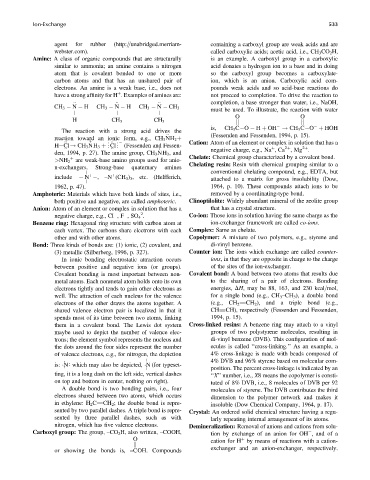Page 578 - Fundamentals of Water Treatment Unit Processes : Physical, Chemical, and Biological
P. 578
Ion-Exchange 533
agent for rubber (http:==unabridged.merriam- containing a carboxyl group are weak acids and are
webster.com). called carboxylic acids; acetic acid, i.e., CH 3 CO 2 H,
Amine: A class of organic compounds that are structurally is an example. A carboxyl group in a carboxylic
similar to ammonia; an amine contains a nitrogen acid donates a hydrogen ion to a base and in doing
atom that is covalent bonded to one or more so the carboxyl group becomes a carboxylate-
carbon atoms and that has an unshared pair of ion, which is an anion. Carboxylic acid com-
electrons. An amine is a weak base, i.e., does not pounds weak acids and so acid-base reactions do
have a strong affinity for H . Examples of amines are: not proceed to completion. To drive the reaction to
þ
:: :: :: completion, a base stronger than water, i.e., NaOH,
CH 3 N H CH 3 N H CH 3 N CH 3
must be used. To illustrate, the reaction with water
j j j
¼ O ¼ O
H CH 3 CH 3 ¼ ¼
is, CH 3 C O H þ OH ! CH 3 C O þ HOH
The reaction with a strong acid drives the (Fessenden and Fessenden, 1994, p. 15).
::
::
reaction toward an ionic form, e.g., CH 3 NH 2 þ Cation: Atom of an element or complex in solution that has a
.
.
þ
H Cl! CH 3 NH 3 þ . Cl . (Fessenden and Fessen-
. :: .
::
::
þ
2þ
2þ
þ negative charge, e.g., Na ,Ca ,Mg .
den, 1994, p. 27). The amine group, CH 3 NH 3 , and
Chelate: Chemical group characterized by a covalent bond.
>NH 2 are weak-base amino groups used for anio-
þ
Chelating resin: Resin with chemical grouping similar to a
n-exchangers. Strong-base quaternary amines
conventional chelating compound, e.g., EDTA, but
N , –N (CH 3 ) 3 , etc. (Helfferich, attached to a matrix for gross insolubility (Dow,
include þ þ
1962, p. 47). 1964, p. 10). These compounds attach ions to be
Amphoteric: Materials which have both kinds of sites, i.e., removed by a coordinating-type bond.
both positive and negative, are called amphoteric. Clinoptilolite: Widely abundant mineral of the zeolite group
Anion: Atom of an element or complex in solution that has a that has a crystal structure.
2
negative charge, e.g., Cl ,F ,SO 4 . Co-ion: Those ions in solution having the same charge as the
Benzene ring: Hexagonal ring structure with carbon atom at ion-exchanger framework are called co-ions.
each vertex. The carbons share electrons with each Complex: Same as chelate.
other and with other atoms. Copolymer: A mixture of two polymers, e.g., styrene and
Bond: Three kinds of bonds are: (1) ionic, (2) covalent, and di-vinyl benzene.
(3) metallic (Silberberg, 1996, p. 327). Counter ion: The ions which exchange are called counter-
In ionic bonding electrostatic attraction occurs ions, in that they are opposite in charge to the charge
between positive and negative ions (or groups). of the sites of the ion-exchanger.
Covalent bonding is most important between non- Covalent bond: A bond between two atoms that results due
metal atoms. Each nonmetal atom holds onto its own to the sharing of a pair of electrons. Bonding
electrons tightly and tends to gain other electrons as energies, DH, may be 88, 163, and 230 kcal=mol,
well. The attraction of each nucleus for the valence for a single bond (e.g., CH 3 –CH 3 ), a double bond
electrons of the other draws the atoms together. A (e.g., CH 2 ¼¼CH 2 ), and a triple bond (e.g.,
shared valence electron pair is localized in that it CH CH), respectively (Fessenden and Fessenden,
spends most of its time between two atoms, linking 1994, p. 15).
them in a covalent bond. The Lewis dot system Cross-linked resins: A benzene ring may attach to a vinyl
maybe used to depict the number of valence elec- groups of two polystyrene molecules, resulting in
trons; the element symbol represents the nucleus and di-vinyl benzene (DVB). This configuration of mol-
the dots around the four sides represent the number ecules is called ‘‘cross-linking.’’ As an example, a
of valence electrons, e.g., for nitrogen, the depiction 4% cross-linkage is made with beads composed of
: j 4% DVB and 96% styrene based on molecular com-
is: N: which may also be depicted, N (for typeset-
:
j position. The percent cross-linkage is indicated by an
ting, it is a long dash on the left side, vertical dashes ‘‘X’’ number, i.e., X8 means the copolymer is consti-
on top and bottom in center, nothing on right). tuted of 8% DVB, i.e., 8 molecules of DVB per 92
A double bond is two bonding pairs, i.e., four molecules of styrene. The DVB contributes the third
electrons shared between two atoms, which occurs dimension to the polymer network and makes it
in ethylene: H 2 C¼¼CH 2 ; the double bond is repre- insoluble (Dow Chemical Company, 1964, p. 17).
sented by two parallel dashes. A triple bond is repre- Crystal: An ordered solid chemical structure having a regu-
sented by three parallel dashes, such as with larly repeating internal arrangement of its atoms.
nitrogen, which has five valence electrons. Demineralization: Removal of anions and cations from solu-
Carboxyl group: The group, –CO 2 H, also written, –COOH, tion by exchange of an anion for OH , and of a
¼ O ¼ cation for H by means of reactions with a cation-
þ
or showing the bonds is, –COH. Compounds exchanger and an anion-exchanger, respectively.

